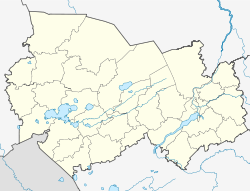Susun
| Urban-type settlement
Susun
Сузун
|
||||||||||||||||||||||||||||||||||
|
||||||||||||||||||||||||||||||||||
|
||||||||||||||||||||||||||||||||||
| List of large settlements in Russia | ||||||||||||||||||||||||||||||||||
Susun ( Russian Сузу́н ) is an urban-type settlement in Novosibirsk Oblast ( Russia ) with 15,364 inhabitants (as of October 14, 2010).
geography
The settlement is located about 150 kilometers south of the oblast capital Novosibirsk in the middle of a large forest area on the river Susun of the same name (also Nizhny Susun , Lower Susun ), a good twelve kilometers above its confluence with the Ob . The closest major city is Barnaul , a good 100 kilometers away , the administrative center of the neighboring Altai region .
Susun is the administrative center of the Susun Rajons of the same name .
history
In 1764, on the orders of Tsarina Catherine II , the construction of a copper smelter for the smelting of the ores mined in the northern Altai Mountains around Kolywan and Smeinogorsk and a mint started on the river Susun ( Turkish-language name of unclear meaning; possibly Green River or Long River ) . The reason was the abundance of forests in the area, as a lot of wood was needed as fuel.
The smelter started operations as early as 1765, the mint in 1766. The copper coins minted first were only valid in Siberia (“Sibirskaja moneta”), but from 1781 throughout the Russian Empire . From 1768 lead and silver ores were also smelted.
The plant and the associated settlement were initially called Nizhne-Susunski sawod ("Lower Susun-Werk"; the river Werchni Susun / Upper Susun flows a few kilometers southeast and flows further above into the Ob), but were in 1828 in Sawod-Susun ("Werk Susun" ) renamed. In 1847 the minting of coins was stopped due to a fire and not resumed, but the smelter was still in operation and annually produced up to 30,000 poods (about 490 t) of copper, but also silver and gold, for example 42 poods (about 690 kg) in 1887. Silver and 1 pud of 15 pounds (over 18 kg) of gold.
Due to the high ore transport costs over 400 kilometers in some cases, the exhaustion of the ore reserves in the production area and the deforestation of the forests around Susun, the decision was made to close the plant in 1889, but it did not finally take place until 1914 with the beginning of the First World War , after only copper remained from 1895 was melted.
In addition, at the beginning of the 20th century, Susun was a locally important handicraft and trading center.
In 1931 the place name was shortened to the current one, and in February 1934 (according to other sources 1939) Susun received the status of an urban-type settlement.
Population development
| year | Residents |
|---|---|
| 1897 | 3,820 |
| 1939 | 7,072 |
| 1959 | 13,778 |
| 1970 | 13,024 |
| 1979 | 13,866 |
| 1989 | 15,470 |
| 2002 | 15,565 |
| 2010 | 15,364 |
Note: census data
Culture and sights
A number of buildings from the late 18th and 19th centuries have been preserved in Susun, including parts of the mint and the copper smelter (partly in ruins), two school buildings and an administration building. In place of the ruins of the Church of the Assumption ( Вознесенская церковь / Voznesenskaja zerkow ), which was blown up in the 1930s , a new church was completed in 2005.
Since 1967 there has been a local history museum in the former administration building of the Kupferhütte, in which, among other things, parts of a steam turbine can be seen, which the inventor P. Salessow, who worked at the Susun plant, constructed in 1806. As in the Novosibirsk State Art Museum, the museum also houses a number of icons from the Susun Icon Workshop. This existed from the end of the 18th to the beginning of the 20th century and established its own style of icon painting, the “Susun School” with painters such as Ivan Krestjanikow (1858–1941).
Economy and Infrastructure
In Susun there are forestry, light and food industries.
In 1962, with the opening of the Central Siberian Railway from Omsk via Karassuk to the Srednesibirskaya station on the Novosibirsk – Barnaul line (route kilometer 668 from Omsk) , Susun received a railway connection. Road link is in the about 80 kilometers away Cherepanovo on the highway M52 (Nowosibirsk- Novoaltaysk at Barnaul- Bijsk - Mongolian limit).
Individual evidence
- ↑ a b Itogi Vserossijskoj perepisi naselenija 2010 goda. Tom 1. Čislennostʹ i razmeščenie naselenija (Results of the All-Russian Census 2010. Volume 1. Number and distribution of the population). Tables 5 , pp. 12-209; 11 , pp. 312–979 (download from the website of the Federal Service for State Statistics of the Russian Federation)
- ↑ Nikolai V. Latkin: Susunski zavod . In: Энциклопедический словарь Брокгауза и Ефрона - Enziklopeditscheski slowar Brokgausa i Jefrona . tape 32 [63]: Судоходные сборы – Таицы. Brockhaus-Efron, Saint Petersburg 1901, p. 26 (Russian, full text [ Wikisource ] PDF ).
- ↑ Local history museum Susun at museum.ru (Russian)
Web links
- Susun Raion Administration website (Russian)



